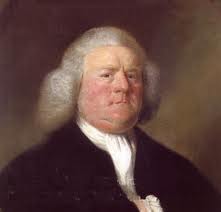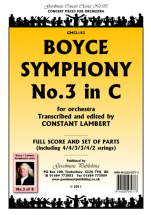Symphonie no.3 in C
Buy this item (out of stock)
Product ID: GM1 CL183
By William Boyce
Publisher:
Goodmusic
Arranger:
Lambert
Series:
Goodmusic Concert Classics
Genre:
Baroque
Line Up:
Symphony Orchestra
Duration:
5'30
Level: 3
Set & Score
This item is out of stock
About this item
There is some
doubt about when William Boyce's eight symphonies were written, but
evidence suggests sometime between 1750 and 1765 and in any case, it was
after the composer had completely lost his hearing.. Although Boyce
called them "symphony" they would now probably be described as "concerto
grosso". The original scoring is for strings with figured bass and
oboes, with the occasional use of flutes, bassoons, horns and trumpets.
In this edition, transcribed and edited by Constant Lambert, there is
no keyboard continuo. The wind parts are largely as Boyce wrote them
but they have been cued in so that it is possible to performthese
symphonies with strings alone, except for No.5 which really does need
trumpets! Similarly the Bass part can be omitted.
A Violin 3 part in lieu of Viola is included which may be used when
violas are few or non-existent.
This edition was originally published in 1928 by Oxford University
Press. This new edition has been re-typeset but is otherwise unchanged.
A PACK comprises one full score and string parts 4/4/3/3/4/2 plus
one of each other part.
Instrumentation
2 Oboes [optional], Bassoon [optional]
Violin 1, Violin 2, Viola (or Violin 3), Cello, Bass
Reviews and rating
No review available, be the first to write one!

Composer
William Boyce (1711-1779)

William Boyce (baptised 11 September 1711 – 7 February 1779) is widely regarded as one of the most important English-born composers of the 18th century.
Born in London, Boyce was a choirboy at St Paul's Cathedral before studying music with Maurice Greene after his voice broke. A house in the present choir school is named after him. His first professional appointment came in 1734 when he was employed as an organist at the Oxford Chapel. He went on to take a number of similar posts before being appointed Master of the King's Musick in 1755 and becoming one of the organists at the Chapel Royal in 1758. One of his students was the prodigy Thomas Linley.
When Boyce's deafness became so bad that he was unable to continue in his organist posts, he retired and worked on completing the compilation Cathedral Music that his teacher Greene had left incomplete at his death. This led to Boyce editing works by the likes of William Byrd and Henry Purcell. Many of the pieces in the collection are still used in Anglican services today.
More info about the composer...



 Click above to view samples
Click above to view samples
